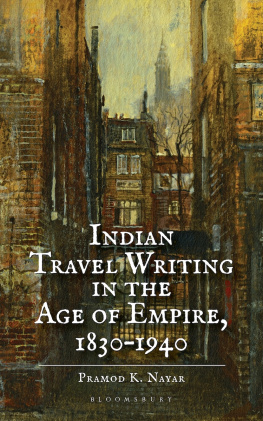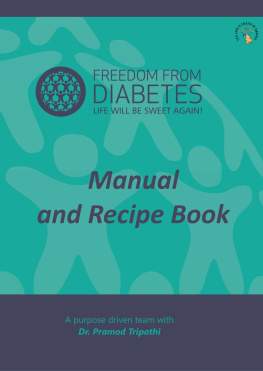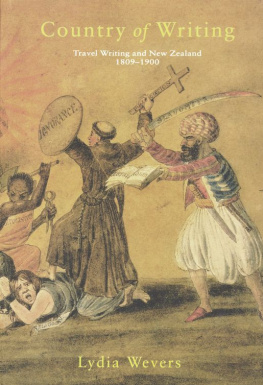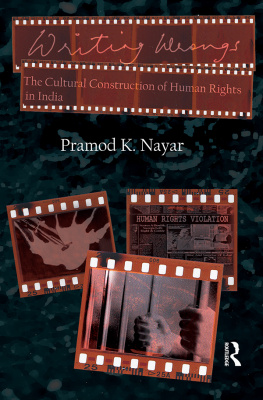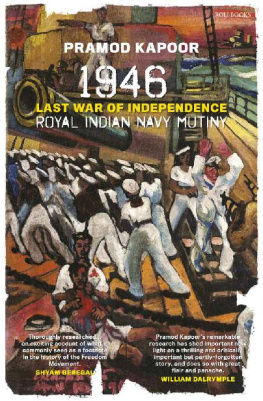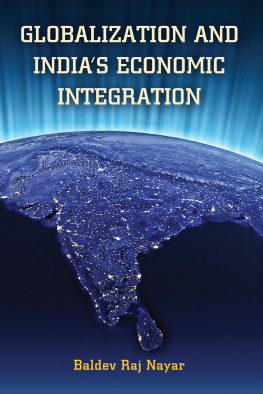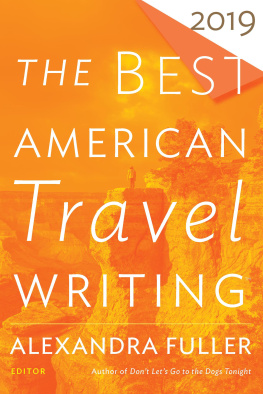Nayar Pramod K. - Indian Travel Writing in the Age of Empire
Here you can read online Nayar Pramod K. - Indian Travel Writing in the Age of Empire full text of the book (entire story) in english for free. Download pdf and epub, get meaning, cover and reviews about this ebook. year: 2020, publisher: Bloomsbury Publishing India Pvt. Ltd., genre: Romance novel. Description of the work, (preface) as well as reviews are available. Best literature library LitArk.com created for fans of good reading and offers a wide selection of genres:
Romance novel
Science fiction
Adventure
Detective
Science
History
Home and family
Prose
Art
Politics
Computer
Non-fiction
Religion
Business
Children
Humor
Choose a favorite category and find really read worthwhile books. Enjoy immersion in the world of imagination, feel the emotions of the characters or learn something new for yourself, make an fascinating discovery.
- Book:Indian Travel Writing in the Age of Empire
- Author:
- Publisher:Bloomsbury Publishing India Pvt. Ltd.
- Genre:
- Year:2020
- Rating:4 / 5
- Favourites:Add to favourites
- Your mark:
- 80
- 1
- 2
- 3
- 4
- 5
Indian Travel Writing in the Age of Empire: summary, description and annotation
We offer to read an annotation, description, summary or preface (depends on what the author of the book "Indian Travel Writing in the Age of Empire" wrote himself). If you haven't found the necessary information about the book — write in the comments, we will try to find it.
Indian Travel Writing in the Age of Empire — read online for free the complete book (whole text) full work
Below is the text of the book, divided by pages. System saving the place of the last page read, allows you to conveniently read the book "Indian Travel Writing in the Age of Empire" online for free, without having to search again every time where you left off. Put a bookmark, and you can go to the page where you finished reading at any time.
Font size:
Interval:
Bookmark:

INDIAN
TRAVEL WRITING
IN THE
AGE OF EMPIRE
INDIAN
TRAVEL WRITING
IN THE AGE OF EMPIRE
18301940
Pramod K. Nayar

BLOOMSBURY INDIA
Bloomsbury Publishing India Pvt. Ltd
Second Floor, LSC Building No. 4, DDA Complex, Pocket C 6 & 7,
Vasant Kunj New Delhi 110070
BLOOMSBURY, BLOOMSBURY ACADEMIC INDIA and the Diana logo
are trademarks of
Bloomsbury Publishing Plc
First published in India 2020
This edition published 2020
Copyright Pramod K. Nayar, 2020
Pramod K. Nayar has asserted his right under the Indian Copyright Act to be identified as
Author of this work
Bloomsbury Academic
An imprint of Bloomsbury Publishing Plc
All rights reserved. No part of this publication may be reproduced or transmitted in any form or by any means, electronic or mechanical, including photocopying, recording, or any information storage or retrieval system, without prior permission in writing from the publishers
Bloomsbury Publishing Plc does not have any control over, or responsibility for, any third-party websites referred to or in this book. All internet addresses given in this book were correct at the time of going to press. The author and publisher regret any inconvenience caused if addresses have changed or sites have ceased to exist, but can accept no responsibility for any such changes
ISBN: HB: 978-93-89000-92-4; eBook: 978-93-89000-94-8
2 4 6 8 10 9 7 5 3 1
Created by Manipal Digital Systems
Bloomsbury Publishing Plc makes every effort to ensure that the papers used in the manufacture of our books are natural, recyclable products made from wood grown in well-managed forests. Our manufacturing processes conform to the environmental regulations of the country of origin.
To find out more about our authors and books visit www.bloomsbury.com and sign up for our newsletters
Contents
I thank Chandra Sekhar of Bloomsbury India for inviting me to submit a book proposal, and for readily accepting this oneit has been in the pipelines for a long time, but it took Chandra Sekhars insistence for it to take concrete shape.
Many thanks to the ecosystem in which most of my travels occur:
My parents; parents-in-law; Nandini and Pranav, and their ever-reliable, loving support for these academic itineraries;
FriendsIbrahim, Josy, Ajeet, Neelu, Vaishali, Haneef, Savitha, Naveed, Premlata, Shruti, Soma for their unfailing enquiries about my perambulations;
Nandanagentle, affectionate and ever-present contributor to the traffic of ideas, and for insistence on proper localizing and historicizing of Theory;
Molly, a.k.a. Chechu, for her prayers, when I set out every time;
Mentor, teacher, biblio-reference desk (also available for online help and consultation), K. Narayana Chandran (KNC), whose knowledge of routes into the most unexpected, and unsuspected, of realms (from St Augustine to Udta Punjab) is matched only by his wit and generosity in being pathfinderto KNC, I owe reams of pages filled with gratitude;
Gratitude, boundless, to my loving interlocutor and friend, Anna Kurian, who flags off the journey, clears the route and ensures my safe runespecially in terms of dodging disasters such as the potholes and obstacles of bad verb forms and thinkingto the destined destination. This one is for you, Anna, fellow traveller through my, what, 40+ books?
To Soma Ghosh, LibrarianEnglish, of the Salar Jung Museum (SJM) Library, I express my special gratitude for finding these texts and for making my Library visits and research so comfortable and fun. Soma was not only thrilled that somebody actually wanted to use these texts, but also began her own project of digging them up and digitizing many of them;
Special mention must be made of the fact that the principal texts discussed here were discovered in a ledger-catalogue at SJM many years ago by Anna. This books journey began with that serendipitous, Columbine moment of discovery; and
To Dinesh at SJM, for his constant good cheer and help, a separate Thank you.
Parts of this book originated in the form of early essays, and I am very grateful to the editors and referees of these journals for their observations and suggestions:
- Colonial Subjects and Aesthetic Understanding: Indian Travel Literature about England, 18701900, South Asian Review 33.1 (2012).
- Beyond the Colonial Subject: Mobility, Cosmopolitanism and Self-fashioning in Sarat Chandra Das A Journey to Lhasa and Central Tibet, New Zealand Journal of Asian Studies 14.2 (2012).
Excerpts from many of the travel narratives used in this book appeared in my edited collection, Indian Travel Writing, 18301947 (5 volumes, Routledge, 2016).
To the reviewer of the manuscript, for incisive comments: this book is better for them, so thank you, wherever you are in the wide, wide world of Indian academia.
A part of Chapter Four, Vernacular Cosmopolitanism in the Age of Empire, was delivered as a plenary talk at the India Travel Writings 1500 2000: Producing Knowledge, Fashioning Selves and Others conference of the Nehru Memorial Museum and Library (NMML), New Delhi, August 2019. I gratefully acknowledge responses to my paper by Kate Teltscher and Joan-Pau Rubis, and thank Rita Banerjee, Fellow of the NMML, for inviting me to the conference. The paper will appear in a volume on travel writing edited by Rita Banerjee.
Travel and Self-fashioning in the Age of Empire
The chief value of travel in foreign countries is to enlarge ones ideas, to make them broad enough for approximation with the ideas of other nationsto make one cosmopolitan, in a word; cosmopolitan, not necessarily in habits and manners, but in sentiments, sympathies and aspirations.
A.L. Roy, Reminiscences English and
American (1888, emphasis added)
The myth that it was Europeans who travelled and discovered various peoples and places of the world has been demolished quite effectively with critical studies of travel writing by non-Europeans in the last few decades. Writing about the knowledge production by non-European and imperial travelling subjects, Paul Smethurst says:
Mobility is the sine qua non of travel writing, and travel writers, having been granted mobility as imperial subjects, then assume the authority to narrate. The duty of imperial travelling subjects is then either to explore and extend the empire, or survey and reconfirm its territories and the within-bounds of the places and peoples of empire. They fit experience and anecdotal evidence to existing structures, maintaining order by acting as intermediaries between the world of experience and accumulated knowledgebetween the empirical and the imperial. (2009: 7)
Smethurst, therefore, sees the travelling imperial subject as fitting into the imperial structures, reinforcing, mediating and translating it.
Work done on native travellers and presences in colonial England by Sukanya Banerjee (2010), Simonti Sen (2005) and Antoinette Burton (1996) has treated the Indian travellers as fitting the category of imperial citizens, and whose writings embody a certain guest discourse (Codell 2007). Elleke Boehmers Indian Arrivals (2015), examining the writingstravel, poetry, memoirsproduced by Indians in England in the 18701915 period, documents how the Indians were influential in English culture, as the metropolis began to engage with the imperial periphery that had folded into its everyday processes and practices.
Font size:
Interval:
Bookmark:
Similar books «Indian Travel Writing in the Age of Empire»
Look at similar books to Indian Travel Writing in the Age of Empire. We have selected literature similar in name and meaning in the hope of providing readers with more options to find new, interesting, not yet read works.
Discussion, reviews of the book Indian Travel Writing in the Age of Empire and just readers' own opinions. Leave your comments, write what you think about the work, its meaning or the main characters. Specify what exactly you liked and what you didn't like, and why you think so.

